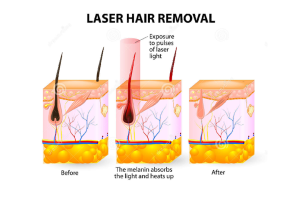Does diode laser hair removal work? ——Hair growth cycle and its relationship with hair removal
2023/05/05
The quest for seamless beauty and immaculate skin invariably involves meticulous hair management as a crucial component. With the current surge in scientific and technological advancements, an array of innovative hair removal techniques have surfaced, notably Diode Laser Hair Removal, which has gained significant traction among consumers owing to its distinct advantages. Despite this popularity, the question remains: Is diode laser hair removal truly effective? In order to address this query comprehensively, it becomes essential first to comprehend the fundamentals of the hair growth cycle and its intricate correlation with hair removal practices.
Hair growth cycle
As a vital facet of our bodies, hair growth is not static but follows a distinctive cyclical progression. It can be broadly categorized into three distinct stages: the anagen, catagen and telogen phases. The anagen phase characterizes the most dynamic stage for each hair strand, constituting approximately 85% of all hairs at any given time. This phase witnesses continuous growth with consistent enhancements in both length and density. Typically, these significant developments transpire over two to six years during the anagen cycle for most hairs. Notably, it’s important to underline that this period may exhibit variances across different areas of hair distribution on the body. As such, one must tailor unique approaches towards effective hair removal strategies corresponding to respective regions.
The regression phase, on the other hand, is the second phase of the hair growth cycle. During this phase, the lower part of the hair follicle, the bulb, begins to gradually shrink. The rate of hair growth slows down significantly until it eventually stops. The regression phase is relatively short-lived, but still has an impact on the overall state of the hair.
The resting phase is the last phase of the hair cycle. During this phase, the hair stops growing and is gradually shed from the follicle. The resting phase usually lasts from 3 to 6 months, after which the hair follicle will enter the anagen phase again and new hairs will begin to grow.
The relationship between hair removal and the hair growth cycle
To understand the hair growth cycle, let’s look at the relationship between hair removal and this cycle. Traditional methods of hair removal, such as razors and depilatory creams, often only remove hair from the surface of the skin without reaching the hair follicle. This means that even if the hair is temporarily removed, new hair will still grow back shortly afterward.
Diode laser hair removal is different. It utilizes laser energy to precisely target the hair mother cells in the hair follicle and inhibits hair growth by destroying these cells. Since the laser energy penetrates deep into the hair follicle, its results are more long-lasting. However, it should be noted that due to the existence of the hair growth cycle, even after the laser hair removal treatment, new hairs may still appear after some time. Therefore, multiple laser hair removal treatments are usually required to ensure the effectiveness of hair removal.
So, how many times does diode laser hair removal actually need to be done? This mainly depends on the individual’s hair condition, the area to be removed and the desired hair removal results. Generally speaking, since the hair cycle of each part of the human body is slightly different and the metabolic cycle of the skin takes 28 days, laser hair removal usually needs to be carried out 4-6 times, each time with an interval of about 30 days. This ensures long-lasting hair removal results while minimizing damage to the skin.
Among the many laser hair removal products available, Nubway stands out for its high efficiency, safety and comfort. Nubway’s diode laser hair removal device utilizes advanced laser technology to precisely target the hair follicle, effectively destroying the hair matrices for long-lasting hair removal results.
Of course, although diode laser hair removal is known as one of the most advanced and effective hair removal methods in the hair removal market, it is not suitable for all people. For certain special groups of people, such as pregnant women and those suffering from skin diseases, you may need to choose your hair removal method carefully. It is also advisable to consult a medical professional or skin specialist before undergoing laser hair removal to ensure safety and effectiveness.
Summary
In essence, the diode laser hair removal modality proves to be a considerably effective and enduring solution for hair elimination. A more profound comprehension of the hair growth cycle coupled with its fundamental relationship to hair removal deepens our understanding of laser-based methods’ effectiveness. However, it’s critical to acknowledge that individual variations in body type and hair conditions necessitate personalized approaches during selection processes for hair removal modalities. Accordingly, professional guidance should always be sought and followed when engaging in these procedures as this optimizes skin health maintenance whilst concurrently striving for aesthetic improvements.
What is the difference between laser hair removal and photon hair removal, and what is the principle of laser hair removal? Continue to introduce in the next issue!







